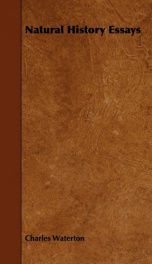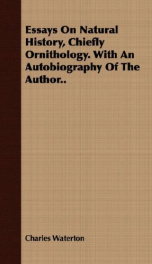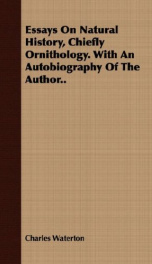Waterton Charles

Charles Waterton (June 3, 1782 – May 27, 1865) was an English naturalist and explorer. "Squire" Waterton was born at Walton Hall, Wakefield, Yorkshire to Thomas Waterton and Anne Bedingfield. He was of a Roman Catholic landed gentry family descended from Reiner de Waterton. His ancestry[1] is alleged to include eight saints: Vladimir the Great, Saint Anna of Russia, the Holy Martyrs Boris and Gleb, Saint Stephen of Hungary, Saint Margaret of Scotland and Saint Mathilde together with Saint Thomas More, Humbert III of Savoy and several European royal families. He was also a descendant of the Old English Chieftain Ailric, Kings Thane to Edward the Confessor, who held Cawthorne and much of South Yorkshire before the Conquest. The heiress Sara le Neville inherited a vast estate from her grandfather Adam FitzSwain (the grandson of Ailric) and it passed to the De Burghes, then they to the Watertons in 1435. The Watertons were one of the few aristocratic families who refused to convert to the new Protestant religion during the reign of Henry VIII, and consequently the vast bulk of their estates were confiscated.[1] Charles Waterton was a devout, ascetic Catholic and maintained strong links with the Vatican. He was educated at Stonyhurst College in Lancashire where his interest in exploration and wildlife were already evident. On one occasion Waterton was caught by the school's Jesuit Superior scaling the towers at the front of the building; almost at the top, the Superior ordered him to come down the way he had gone up.[2] Whilst at the school, he records in his autobiography that "by a mutual understanding, I was considered rat-catcher to the establishment, and also fox-taker, foumart-killer, and cross-bow charger at the time when the young rooks were fledged. . . I followed up my calling with great success. The vermin disappeared by the dozen; the books were moderately well thumbed; and according to my notion of things, all went on perfectly right."[3] In 1804 he travelled to British Guiana to take charge of his uncle's estates near Georgetown. In 1812, he started to explore the hinterland of Guiana, making four journeys between then and 1824, and reaching Brasil on foot - barefoot - in the rainy season. He later described his discoveries in his book Waterton's Wanderings in South America[1] which inspired young British schoolboys like Charles Darwin and Alfred Russell Wallace. He was a highly skilled taxidermist and preserved many of the animals he encountered on his expeditions. However, he employed a unique method of taxidermy, soaking the specimens in what he called "sublimate of mercury." Unlike many preserved ("stuffed") animals, his specimens are hollow - and are surprisingly lifelike, even today. He also displayed his anarchic sense of humor in some of his taxidermy: a famous tableau he created (now lost) consisted of reptiles dressed as famous Englishmen and entitled "The English Reformation Zoologically Demonstrated." Another specimen was the upper half of a howler monkey contorted to look like an Amazonian Abominable Snowman and simply labelled "The Nondescript." This specimen is still on display at the Wakefield Museum. Whilst in Guiana he taught one of his uncle's slaves, John Edmonstone his skills. Edmonstone, by then freed and practising taxidermy in Edinburgh, in turn taught the teenage Charles Darwin. Waterton is credited with bringing the anaesthetic agent curare to Europe. In the 1820s he returned to Walton Hall and built a nine-foot-high wall around three miles (5 km) of his estate, turning it into the world's first wildfowl and nature reserve, making him one of the western world's first environmentalists. He also invented the bird nesting box. The Waterton Collection, on display at Stonyhurst College until 1966 is now in Wakefield Museum. Waterton died after fracturing his ribs and injuring his liver in a fall on his estate. His body is interred near the spot where the accident happened. His coffin was taken from the hall to his chosen resting place by barge, in a funeral cortege led by the Bishop of Beverley, and followed at the lakeside by many local people. The grave was between two oak trees which have now disappeared. It is said that a flock of birds followed the barge, and a linnet sang as the coffin was being lowered. On May 11, 1829 at the age of 47 he married 17 year old Anne Edmonstone. Anne was the granddaughter of an Arawak Indian and Scottish royalty. "His wife died shortly after giving birth to their son, Edmund. She was only 18. After her death he slept on the floor, with a block of wood for a pillow." [4] A range of colourful stories have been handed down about Charles Waterton, not all of which are verifiable, but which add up to a popular portrait of an archetypal aristocratic eccentric: Waterton was an early opponent of pollution. He fought a long-running court case against the owners of a soapworks which had been set up near his estate in 1839, and sent out poisonous chemicals which severely damaged the trees in the park and polluted the lake. He was eventually successful in having the soapworks moved.
do you like this author?
What readers are saying
What do you think? Write your own comment on this book!
write a commentWhat readers are saying
What do you think? Write your own comment on this author!
write a commentBook list

natural history essays
Series:
Unknown
Year:
Unknown
Raiting:
3/5
Many of the earliest books, particularly those dating back to the 1900s and before, are now extremely scarce and increasingly expensive. We are republishing these classic works in affordable, high quality, modern editions, using the original text and artwork.
Show more
add to favoritesadd In favorites

essays on natural history chiefly ornithology
Series:
Unknown
Year:
Unknown
Raiting:
4.5/5
Many of the earliest books, particularly those dating back to the 1900s and before, are now extremely scarce and increasingly expensive. We are republishing these classic works in affordable, high quality, modern editions, using the original text and artwork.
Show more
add to favoritesadd In favorites

essays on natural history
Series:
Unknown
Year:
Unknown
Raiting:
3.5/5
Many of the earliest books, particularly those dating back to the 1900s and before, are now extremely scarce and increasingly expensive. We are republishing these classic works in affordable, high quality, modern editions, using the original text and artwork.
Show more
add to favoritesadd In favorites
Book list

natural history essays
Series:
Unknown
Year:
Unknown
Raiting:
3/5
Many of the earliest books, particularly those dating back to the 1900s and before, are now extremely scarce and increasingly expensive. We are republishing these classic works in affordable, high quality, modern editions, using the original text and artwork.
Show more
add to favoritesadd In favorites

essays on natural history chiefly ornithology
Series:
Unknown
Year:
Unknown
Raiting:
4.5/5
Many of the earliest books, particularly those dating back to the 1900s and before, are now extremely scarce and increasingly expensive. We are republishing these classic works in affordable, high quality, modern editions, using the original text and artwork.
Show more
add to favoritesadd In favorites

essays on natural history
Series:
Unknown
Year:
Unknown
Raiting:
3.5/5
Many of the earliest books, particularly those dating back to the 1900s and before, are now extremely scarce and increasingly expensive. We are republishing these classic works in affordable, high quality, modern editions, using the original text and artwork.
Show more
add to favoritesadd In favorites
What readers are saying
What do you think? Write your own comment on this author!
write a commentif you like Waterton Charles try:
readers also enjoyed
What readers are saying
What do you think? Write your own comment on this author!
write a commentGenre
if you like Waterton Charles try:
readers also enjoyed
Do you want to exchange books? It’s EASY!
Get registered and find other users who want to give their favourite books to good hands!


